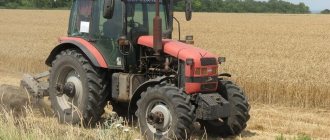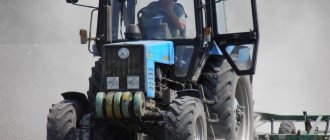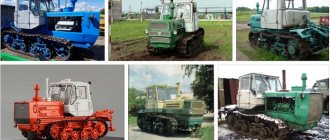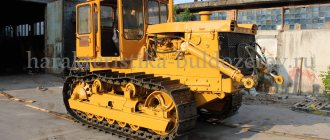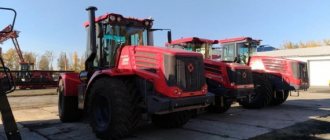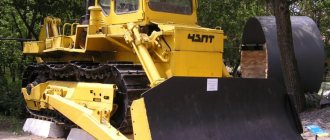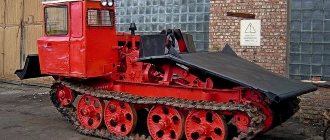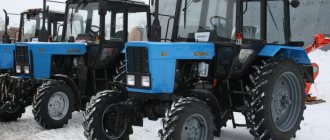Author: Ivan Rzhanov
06 November 2021 21:47
Tags: USSR Tractors agriculture
8841
5
1
The first Soviet five-year plans were a resounding success. Agriculture was one of the main elements. At the same time, Soviet production was developing at a tremendous pace in the USSR, in particular, modern tractors were created and produced, which were so necessary for developing agriculture. But what were they?
Wheel tractor "Universal 2"
0
See all photos in the gallery
Universal tractors were produced from 1934 to 1940 at the Leningrad and from 1944 to 1955 at the Vladimir Tractor Plant. The cars of the first series Universal-1 and Universal-2 differed in the design of the front axle. The U-1 had front wheels offset to the center, on the U-2 they were spaced apart on the beam of the front axle. Accordingly, the tractor had additional tie rods. The tractor was equipped with a 4-cylinder 22 hp kerosene engine. and a transmission with three forward and one reverse gears. The operating speed range of the U-2 tractor was from 3.9 to 8.1 km/h with an operating weight of 2108 kg. It was the Universal-2 that became the first Soviet tractor to be exported. The total number of released Universals is 211,500 pieces.
Remembering Belarus. The history of MTZ wheeled tractors began 65 years ago. What were the firstborns like?
Recently, the Minsk Tractor Plant celebrated its anniversary: 65 years since the start of serial production of the first wheeled tractor "Belarus" MTZ-2. And we decided to remember what kind of car it was: what design it had, what characteristics it had, what it was intended for, what it was capable of and what “offspring” it gave ...
In order to more clearly understand the circumstances under which the production of the first "wheels" began in Minsk, let's go back to history a few years earlier. The decision to build a tractor plant in the capital of the Byelorussian SSR was made on May 26, 1946 by the Council of Ministers of the USSR. At the same time, the Minsk Tractor Plant was originally created for the production of row-crop caterpillar tractors of medium power of the Kirovets type D-35 (KD-35).
Cultivated tracked tractor "Kirovets" D-35. Photo by MTZ OJSC
Work on this machine in the USSR began back in the 1930s at the Kirov Plant in Leningrad, the American tractor Caterpillar R2 served as a prototype for it. The implementation of the project was prevented by the Great Patriotic War, but already in 1943, work on the new tracked vehicle was resumed: the development of design documentation was continued by the specialists of NATI (then the Scientific Automotive and Tractor Institute), and Lipetsk was chosen as the place of production of the tractor, where a new tractor plant was organized at the facilities. Serial production of caterpillar "Kirovtsev" with a diesel engine began there in 1947.
Cultivated tracked tractor "Kirovets" D-35. Photo techstory.ru
However, the country needed a lot of tractors, so the Minsk Tractor Plant, which was under construction, also received the task for the production of KD-35. The project provided for the production of up to 50 caterpillar tractors per day. The plant also had to establish the production of diesel (D-35) and starting (PD-10) engines. Production was mastered in stages during the construction of the enterprise. In November 1950, Minsk residents began to collect caterpillar "plowmen".
True, the KD-35 was produced in Minsk for a short time - until August 1951, after which its production was transferred to the Romanian Brasov. 406 caterpillar tractors were assembled at MTZ in 9 months.
Photo NUK "Scientific and technical museum of the history of the tractor"
At the same time, the production of skidders for the timber industry, transferred to Minsk from the Kirov Plant, was launched at MTZ. In 1951, the production of the KT-12A model with a 36-horsepower UralZIS-352T gas generator engine began (the first batch of machines was assembled in August). In 1956, a TDT-40 diesel skidder, which was equipped with a 40-horsepower D-40T engine, could remove up to 5 cubic meters of wood from a cutting area in one run. Even more advanced skidders, TDT-54 and TDT-60, were also developed in Minsk.
Skidding tractor KT-12. Photo techstory.ru
The production of diesel engines D-35 and launchers did not stop in Minsk - they were supplied to the Lipetsk Tractor Plant to equip the KD-35 / KDP-35 models, and were also installed on the first MTZ-1 / MTZ-2 wheeled tractors.
The “wheeled” theme in Minsk arose in May 1948, when the plant was instructed to design a universal wheeled tractor with a 37-horsepower diesel engine and a hydraulic hitch system for the first time in the USSR to do without a trailer.
In October 1948, a draft technical design of the tractor was completed in two modifications: MTZ-2 - for inter-row processing of low-stemmed crops with the same track of the front and rear wheels; MTZ-1 - for processing tall crops with close front wheels.
In July 1949, the first prototype of a wheeled tractor came out of the gates of the experimental workshop, which became the basis for creating a serial machine. In addition to it, six more prototypes were produced, all of them went to long-term factory tests. Even then, at the suggestion of the chief designer of MTZ Ivan Iosifovich Drong (he worked in Minsk in 1949-1963), the family of wheeled tractors was named "Belarus".
MTZ-2. Photo by MTZ OJSC
It was planned to launch the mass production of wheeled tractors at the plant in July 1953, but the start of production was delayed for various reasons. And finally, on October 14, the first serial tractor "Belarus" MTZ-2 of traction class 1.4 rolled off the main conveyor of tractor assembly shop No. 2.
The first serial MTZ-2. Photo by MTZ OJSC
The first MTZ wheeled tractors. Photo by Alexander Ditlov
Made according to the "classic" scheme, the first Minsk "wheel" was equipped with a vortex chamber four-stroke four-cylinder diesel engine D-36 manufactured by MTZ (it differed from the D-35 in a lightweight radiator and oil pan). Here are the main characteristics of this motor: working volume - 4.08 liters; rated power - 37 hp at 1400 rpm; the highest torque is 23 kgf m (225.6 Nm) at 900 rpm. Hourly fuel consumption at maximum tractor load is 7.92 kg/h. Fuel - diesel (GOST 4749-49). Engine weight (dry) - 740 kg.
The engine was attached to a semi-frame frame, which formed the engine subframe (two channels interconnected by a front beam) and power transmission housings (clutch, gearbox, rear axle). The main diesel engine was started by a PD-10 starting engine (carburetor, two-stroke, single-cylinder, 10 hp).
The gearbox on the MTZ-2 was a mechanical 5-speed (number of forward gears - 5, reverse - 1). The main gear is bevel gears with a straight tooth. The differential is simple, conical, with two satellites of an open type, with a locking mechanism. Final drives - spur gears with a straight tooth. Travel speeds (calculated): in first gear - 4.56 km / h; on the fifth - 12.95 km / h. You say quiet?
The front axle is a tubular telescopic beam, swinging in a bracket attached to the front beam. The steering is a worm gear pair of a globoidal worm and a three-ridged roller. Shoe brakes are installed on independent shafts connected by gears to the leading axle shafts. Brake control - from the pedals, optionally separate or interlocked.
The driving and steering wheels are equipped with low-pressure pneumatic tires (there was also an option with metal wheels with spurs in the project).
Electrical equipment - alternating current generator G31-A2 with a power of 60 watts. The battery was not provided, as was the sound signal. Lighting - two FG-18 type headlights in front and one in the back with a semi-collapsible elliptical element.
The workplace of the tractor driver on the MTZ-2 was distinguished by Spartan simplicity. Above the fuel tank, in special guides welded to the wings, a tool box was installed, which served as the frame for a double seat. The steering wheel is on the right side. The cabin was not provided at all (for the first time, a closed cabin with the possibility of conversion into a semi-open or closed-type awning appeared only in 1960 on the MTZ-5MS and MTZ-5LS models).
Tractor MTZ-2. Photo techstory.ru
Instrumentation - oil and water thermometers and oil pressure gauges (one shows the pressure in the oil line, the second - after the fine filter).
The MTZ-2 tractor had a power take-off shaft (PTO) with a dependent drive from the intermediate shaft of the gearbox. The number of revolutions per minute of the PTO is 520. For work with stationary machines, a drive pulley was provided (its diameter is 320 mm; width - 200 mm; the number of revolutions per minute is 828) driven by the PTO.
The weight of the unfilled tractor was 3250 kg. Basic refueling volumes: fuel tank of the main fuel - 100 l; starting fuel tank - 3 l; cooling system - 29 l; gearbox and rear axle housing - 45 l; the total capacity of the hydraulic system is 6 liters.
Type of hitch - pendulum, rigid, adjustable. Hydraulic system for lifting attachments - with one separately controlled double-acting cylinder. The attachment mechanism for agricultural implements is a articulated four-bar linkage. Pulling force on the hook - 1400 kgf (in first gear).
The wheelbase of the MTZ-2 tractor was 2380 mm. Length - 3678 mm. Width (along the protruding ends of the axle shafts of the rear wheels) - 1884 mm. Height (along the steering wheel) - 1900 mm. The track width of the front and rear wheels is variable in the range from 1200 to 1800 mm. Ground clearance: under the rear axle - 440 mm; under the front axle - 525 mm. The smallest turning radius is 3.7 m.
Among other technical characteristics, the following were also indicated: overcome the rise - 27 degrees; ice thickness at which tractor movement is safe - 17-19 cm; means of transportation - ZIS-151, ZIS-157.
MTZ-2 was aggregated with almost two dozen agricultural machines and implements. It could be used for work on the care and harvesting of row crops, plowing light soils, pre-sowing cultivation, sowing and harvesting grain crops, as well as for driving stationary agricultural machines and as a vehicle.
Against the background of other Soviet tractors produced at that time, the MTZ-2 looked very progressive. Indeed, even before 1955, the Vladimir Tractor Plant produced such Universal tractors with metal wheels and spurs, which were equipped with kerosene carburetor engines with a capacity of 22 liters. With. The release of "Universal" started at the Kirov plant in Leningrad back in 1934, but even after 20 years they were considered first-class because of the cheapness and ease of maintenance - the time was not easy ...
Photo NUK "Scientific and technical museum of the history of the tractor"
But such a universal garden tractor XTZ-7 was produced at the Kharkov Tractor Assembly Plant (1950-1956) and the Kharkov Tractor Plant (1955-1956). The model was equipped with a gasoline carburetor two-cylinder engine with a capacity of 12 hp.
In 1957, in Kharkov, they switched to the production of the DT-14 tractor with a single-cylinder diesel engine with a capacity of 14 forces. This model was replaced by the DT-20 tractor with an 18-horsepower engine. It was produced at the Kharkov Tractor Plant from 1958 to 1969.
Photo NUK "Scientific and technical museum of the history of the tractor"
At the Vladimir Tractor in 1955, he gave way to the universal row-crop tractor DT-24 on pneumatic tires. And since 1958, the production of 28-horsepower tractors T-28 "Vladimirets" has been launched here.
Nevertheless, it was the MTZ-2 that went down in history as the first mass domestic wheeled universal row-crop tractor on pneumatic tires. This model was also produced at the Southern Machine-Building Plant in Dnepropetrovsk (1954-58). A total of 148,800 tractors "Belarus" MTZ-2 were manufactured.
Tractor MTZ-5 in Saratov, on Sokolovaya Gora. Zimin Vas Photos
After the first significant modernization, which ended in 1957, the Belarus tractor began to be produced under the MTZ-5 index. This model was distinguished by the use of a more powerful 40-horsepower D-40K engine, a 10-speed gearbox (which made it possible to expand the speed range from 0.82 to 20.75 km / h), a double clutch and an independent power take-off shaft (PTO) drive ), the presence of two remote cylinders and a three-spool distributor. The power of the generator used for lighting was 180 watts and was sufficient to power four headlights of a tractor and two headlights of a trailed agricultural machine. The front wheels are wider (tire size 6.50-16). The weight of an unfilled tractor has decreased from 3250 to 2850 kg.
Tractor MTZ-5 in Saratov, on Sokolovaya Gora. Zimin Vas Photos
In 1957, for several months, a modification of the MTZ-5K was produced with a separate-aggregate hydraulic system. Since 1958, the production of MTZ-5L and MTZ-5M tractors began with 45-horsepower D-40L / 40M engines and started, respectively, using a PD-10M starting engine and an electric starter.
Tractor MTZ-5MS. Photo autowp.ru
Since 1960, tractors of new modifications MTZ-5LS and MTZ-5MS began to roll off the assembly line, which were equipped with 48-horsepower D-48L / 48M diesel engines and were designed to perform various agricultural work at high speeds. For the first time on these tractors, a detachable closed-type cab appeared, which could easily be converted into a semi-open or open cab with an awning. The transport speed has increased to 22 km/h.
In the late 1950s, in Minsk, on the basis of the "five", the first tractor "Belarus" with all-wheel drive was created. This model received the MTZ-7 index. The new all-wheel drive tractor had increased traction and coupling properties and high cross-country ability, which made it possible to expand the scope of the “wheels” in agriculture and in some places even replace tracked vehicles with them.
On the MTZ-7, the drive to the front drive axle (in which, by the way, a number of front axle units of the GAZ-63 truck was used) was carried out by a cardan shaft through a constantly on friction clutch from the transfer case. Oversized low-pressure tires 9.0-20 were used in front.
Since 1959, MTZ-7L and MTZ-7M tractors with 45-horsepower D-40L and D-40M engines have been mass-produced. A year later, the production of new modifications MTZ-7LS and MTZ-7MS began, equipped with 48 hp engines, as well as removable cabs.
Tractor MTZ-50L, manufactured in 1966
The production of wheeled tractors "Belarus" of the first generation continued in Minsk for a little less than 10 years: since 1962, the plant began to produce more advanced MTZ-50. First, the transitional model MTZ-50PL went into production with a power boost of 50 hp. engine D-48PL, and since 1964 mass production of tractors MTZ-50 and MTZ-52 began with a new 55-horsepower D-50 engine, the production of which was launched at the newly commissioned Minsk Motor Plant.
This MTZ-50 tractor left the assembly line in 1970
Tractors of the MTZ-50/52 family lasted on the assembly line until 1985. Over time, their appearance has changed. At first, cars were produced with a semicircular radiator grille and a frameless cab with a canvas roof. Since the late 1960s, the radiator grill has become rectangular, the design of the hood has changed. In the late 1970s, an enlarged frame cab with a fiberglass roof was installed on MTZ-50/52 tractors.
As for the very first tractor "Belarus" MTZ-2, released in 1953, it has survived to this day. From the factory, this machine entered the collective farm "Bolshevik" of the Kopyl district, where the machine operator Savely Mironenko worked on it for 17 years. And on the eve of its 25th anniversary, the Minsk Tractor Plant returned the wheeled first-born to itself, exchanging it for a brand new MTZ-50. In Minsk, a rare tractor was installed on a pedestal and continued to keep its watch at the factory gate for several decades.
In 2021, on the eve of the 70th anniversary of the plant, the tractor-monument was restored and moved to the square, laid out near the walls of the enterprise. Here, awards are now presented to the best tractor builders, solemn events are held, and foreign delegations are received.
It should be noted that Minsk tractor manufacturers are anxious about the history of their enterprise. In the museum of the Minsk Tractor Plant, among the existing exhibits, there is another MTZ-2 tractor (No. 10, manufactured in 1953), as well as an all-wheel drive MTZ-7MS (manufactured in 1958), MTZ-50 (assembled in 1970) , anniversary - "millionaire" MTZ-52, released in 1972, and the two millionth MTZ-82, which rolled off the main conveyor on March 26, 1984. All of them were issued under the brand name "Belarus".
Sergey GRISHCHENKO ABW.BY Photo by the author, OJSC MTZ, techstory.ru, Scientific and Technical Museum of Tractor History
See what tractors are for sale in our ad database.
Wheeled tractor SHTZ-15/30
0
The most massive Soviet wheeled tractor of the first half of the 20th century, 390,500 copies were produced. Produced at the Stalingrad Tractor Plant (since 1930) and the Kharkov Tractor Plant (since 1931) until 1937, and in the post-war period (1948-1950) at the Moscow Automobile Repair Plant. The design is based on one of the best wheeled tractors of the time McCormick-Deering 15/30 of the American company International Harvester. The kerosene 4-cylinder engine developed 31.5 hp. and allowed to work in the speed range from 3.4 to 7.4 km / h. The operating weight of the tractor is 3000 kg.
How a Russian self-taught mechanic got ahead of the whole world
On March 27 , 1878, the self-taught Volga steamship engineer Fedor Abramovich Blinov applied to the Department of Trade with a request to issue him a patent “for a special arrangement of a wagon with endless rails for transporting goods along highways and country roads.”
Fedor Blinov was born in the village of Nikolskaya, Volsky district, Saratov province. in the family of a serf-old believer. The village was part of the estate of the famous Uvarov family.
According to legend, his owner, Minister of Public Education and President of the Academy of Sciences Sergei Semyonovich Uvarov, noticed Blinov’s natural strength and ingenuity and sent the young man to work in a rural forge, and during the period of sending grain by barges along the Volga, he included him in the cooperative of loaders.
Fascinated by the steamship business, Blinov began to earn extra money on the Volga during the navigation period as a fireman, then as an assistant driver.
It was in the "position" of the machinist that he first showed himself as an inventor.
Floating along the Volga, Blinov got excited about the idea of making a model car with an endless chain-like rail.
Such a model was made in 1877 and Blinov decides to go to St. Petersburg himself, to apply for a “privilege” for his invention.
On the advice of Count Orlov-Denisov, he met with an influential dignitary K.F. Bentkovsky, who made sure that the technical society of St. Petersburg heard the provincial mechanic.
We also managed to arrange a meeting with the Minister of Railways, Admiral K.N. Posyet, which, in fact, set the course in motion.
On January 18, 1878, Blinov paid 40 kopecks for the stamp duty, and on January 21, the ministerial clerk, after pasting the stamp, at his request, drew up a document in beautiful large handwriting:
“Ministry of Railways of March 14, 1878 No. 3418. To Fyodor Abramovich Blinov.
... Having recognized the merit of your wagon in achieving a reduction in traction force from 6 to 7 times compared to the usual way of transporting goods along the highway, T.I.C.U. about the possibility of practical application of the projectile in the form as it is proposed by you, mainly in view of the significant number of pairings of the chain, which can break in pairings when the track is uneven, and also the lack of sufficient play in the grooved rail when passing curves described by a radius of 100 feet. We are returning the drawings and the note.”
Steam caterpillar tractor F. Blinov, with metal tracks . Photo (c) pro-tank.ru
On September 20, 1879, the long-awaited “privilege” was issued in the name of the peasant owner Fyodor Blinov, registered in the Code under No. 64:
“When the wagon moves, the wheels roll along the smooth chain-like surface of the rails. The rail lying on the wheels will pass into the front guide (sprocket), laying the path for further movement, while the rear guide will remove the rails from the road and transfer the rails to the next guide in front. Thus, in front of the car, a constant, endless path will be built in the desired direction.
Photo (c) pro-tank.ru
At the end of 1880, his caterpillar “wagon” was already being tested, it had a device similar to a wagon and developed a speed of up to 3 miles per hour (3.2 km / h).
The inventor for the first time managed to solve the problem of turning a caterpillar self-propelled vehicle due to the unequal speeds of movement of the tracks, that is, in the same way as on all modern tracked vehicles. True, now for this purpose not a steam engine is used, but turning mechanisms called side clutches, but the principle proposed by Blinov is still at the heart of it.
The world's first steam caterpillar tractor by Russian inventor Fyodor Blinov
In 1896, the tractor was demonstrated at the Nizhny Novgorod Industrial Exhibition. But the jury members did not appreciate the enormous significance of this invention. They only decided to issue "peasant Fyodor Blinov a commendable review for a steam locomotive for country roads with endless rails and for diligence in its manufacture."
Here is what the Volgar newspaper wrote about this: “The trouble is that Russian inventors are RUSSIAN. We have no confidence in our own creative powers and abilities, no desire to support even an undeniably useful cause, and it is not surprising if Russian inventions fall into the hands of the British, Americans and French.
What was clear to journalists was not understood by those in power.
Kaspiy newspaper: “The exhibitor is a peasant from the Saratov province. F. Blinov demonstrates to the public a steam engine adapted to transport cargo on highways and dirt roads. We had to talk to the inventor of this engine. He complained bitterly about his fate: for 16 years since he invented this engine, he even took a privilege on it, but still he could not find a capitalist who would undertake to manufacture it in a factory way. Even the existing gaps in the exposed engine, which cost him 10 thousand rubles, he undertakes to improve so much that entire trains will fly along the ground as if on rails. But the marshals do not hear the call.
Blinov's self-propelled model Photo (c) mirvremeni.ru
Unlike the short-sighted Russian officials, the Germans became interested in the invention of the self-taught mechanic, who expressed a desire to buy a tractor, but Blinov did not agree that a foreign brand should be on his offspring, and refused to sell it.
“I am a Russian peasant, I thought and did for Russia.”
The last years of his life, a talented inventor successfully worked on a project of a tractor with an internal combustion engine, but he did not have time to complete it, death prevented him.
Caterpillar tractor STZ-3 (SHTZ-NATI)
0
After the cessation of production of the SKhTZ-15/30 wheeled tractor in 1937, the Stalingrad and Kharkov Tractor Plants switched to the production of the STZ-3 caterpillar tractor. It was the first mass-produced tractor, the design of which was completely developed by Soviet engineers. The tractor had a riveted frame, a chassis of four carriages with a balancing suspension with coil springs and a semi-enclosed cab. A 4-cylinder water-cooled kerosene engine developed 52 hp. on the shaft and 46 hp on the drive pulley. The mass of the tractor was 3800 kg. After the evacuation of the Kharkov plant to the city of Rubtsovsk, STZ-3 was also produced at the Altai Tractor Plant (from 1942 to 1952). In Stalingrad and Kharkov, the production of STZ-3 was curtailed a little earlier, in 1949, when it gave way to the DT-54 tractor on the conveyor. The total number of cars produced is 191,000 pieces.
From a locomobile to a tractor and a tank
The mass use of wheeled tractors in agriculture began less than 100 years ago, when internal combustion engines were installed instead of steam ones.
Caterpillar steam tractors, seemingly originally designed for off-road use, were not suitable for plowing the land. The engine power was too small, and the weight too great to pull a ten-ton colossus out of wet soil, even without a plow. But locomobiles were able to adapt to agricultural needs: the car moved on the edge of the field or the roadside, and the plow moved across the field using a cable system.
Since the seventies of the XIX century, they have been widely used in the Russian Empire. So, in the village of Timashevo, Samara province, 10 Fowler steam tractors worked. They worked in the beet fields and at the local sugar factory. They served as fuel ... straw! Domestic machine builders were able to quickly establish their own production of such machines. The first Russian locomobile was produced in 1875 at the Lyudinovsky locomotive plant of the Maltsovskie Zavody joint-stock company. Others followed after him. This is not surprising: the demand for technology has grown every year. In 1875, 1.3 thousand locomobiles were used in the agriculture of the Russian Empire, in 1901 - 12 thousand, and in 1904 - 17,287 units.
In 1911, Russian inventor Yakov Mamin created a machine that he called "Russian Tractor 2". After minor modifications, it was launched into a series and by 1913 163 cars had been assembled. Not much, but against the backdrop of global indicators - not bad. In the United States, for example, before the First World War, no one considered the production of tractors as a serious business.
Tractors were still outperforming horses on a cost/performance basis. And not only in the Russian Empire, where the main agricultural producers were individual peasants with small plots of land - sometimes the tractor would not turn around. Even in the US, with large plots of land, farmers in the mid-twenties were more likely to buy cars than tractors.
In 1907, the designers of Henry Ford created a project for a tractor with an internal combustion engine, but it was not possible to launch it into mass production. In 1915 he made a second attempt. Again unsuccessful. Ford Motor Company shareholders blocked his initiative. The founder had to create a new company for the production of Fordson tractors ("Ford and Son"). The first order was received from abroad in May 1917, even before the launch of the plant. The British government decided to organize the plowing of wastelands with the help of 5 thousand tractors. By the early twenties, Fordson had become the most common model in the world.
The technical innovation did not pass by the attention of the Soviet government. In March 1918, Yakov Mamin met with Vladimir Lenin, who enthusiastically picked up the idea of creating a domestic tractor. A year later, in March 1919, speaking from the rostrum of the VIII Party Congress, Vladimir Lenin voiced the idea of 100,000 tractors for Soviet Russia. In April 1919, the Commission for Tractor Engineering was formed under the Supreme Council of National Economy, but the results of its activities were modest. They managed to produce no more than 500 cars of one model. For an agrarian country, which at that time was Russia, it was a drop in the ocean. Only in 1924 did the USSR manage to mass-produce wheeled tractors.
By that time, Yakov Mamin, based on his Russian Tractor 2, had created a three-wheeled version called the Gnome. A unique machine when compared with imported analogues. For example, if the "Fordson" consisted of 1500 parts, then the "Gnome" of only 300, which greatly facilitated its repair and maintenance. The domestic car was lighter - less than one and a half tons - and multifunctional. It could carry on a cart a load weighing up to 4 tons at a speed of 4 km / h, pull a plow or reapers, and also serve as an engine for pumps, mills, threshers and other agricultural mechanisms. In parallel with the Gnome, since 1923, the Zaporozhets wheeled tractor was produced, designed to process small peasant allotments. Until 1927, about 500 cars were made.
Tractor "Kolomenets 1"
In the same 1923, Soviet newspapers reported on the creation of the Kolomenets tractor, designed for plowing, sowing, and threshing. It could also feed a generator, the energy of which was enough to light a village of 500 houses. True, the authors kept silent about the fact that the pre-revolutionary American Mogul tractor served as its prototype. The sample turned out to have too many components and assemblies that were difficult to manufacture and operate, so the engineers made a number of changes to the design. As a result, the weight of the machine has decreased from 4 to 2.7 tons, although the power has also decreased by a third. There were other problems that prevented the creation of a reliable car. From 1923 to 1925, 231 Kolomenets of four modifications were produced.
In 1924, Yakov Mamin designed a new "peasant" tractor "Karlik". The engine of this car consumed significantly less fuel than the Zaporozhets. And significantly, almost twice, he won in weight and at the same time in draft strength. According to this indicator, he surpassed even the Fordson. "Dwarfs" were produced in three-wheeled and four-wheeled versions.
Mamin's improvements - for example, lugs on wheels began to be used all over the world .. The production of "Dwarfs" was stopped at the end of the twenties, when collectivization began. In place of small farms, huge collective farm fields appeared, for which other equipment was required.
Tractor "Fordson-Putilovets"
By that time, the Fordson-Putilovets, produced under an American license, was the most massive tractor. From 1924 to 1932, up to 42 thousand cars were assembled at Leningradsky. This model had only one drawback. Initially, it was intended for farms, and its resource was calculated for 500-600 hours of work per year. Under the conditions of collectivization, it became impossible to comply with it. Working with increased load invariably led to massive breakdowns and accidents. And the model itself was morally and technically obsolete by the beginning of the thirties.
Since 1930, mass production of SHTZ 15/30 began in the USSR. Until 1950, 390.5 thousand cars were produced. The tractor was developed on the basis of the design of one of the best tractors of that time, the American International McCormick Dearing 15/30.
Tractor SHTZ 15/30
On June 17, 1930, the first SHTZ 15/30 rolled off the assembly line of the Stalingrad Tractor Plant (STZ). In the fall of the following year, they began to produce it in Kharkiv at KhTZ, but in 1937 it was replaced with a caterpillar SKhTZ-NATI instead - the first mass-produced tractor of a completely domestic design.
By the end of 1937, the Stalingrad plant mastered the production of a transport tractor (artillery tractor) STZ-5 "Stalinets", which at the beginning of the war became the main "workhorse" of the Red Army.
At the beginning of 1941, the production of T-34 tanks and V-2 tank diesel engines began at the STZ, as well as. when the Great Patriotic War broke out - and other military vehicles, tracked tractors. The release was carried out even when the Wehrmacht broke through to Stalingrad. Production was stopped only when the fighting was already going on directly on the territory of the plant.
During the defense of Odessa, STZ-5 tractors were used as a chassis for surrogate tanks "NI" ("At Fright") with thin armor and machine-gun armament, usually taken from obsolete or wrecked armored vehicles.
Light tank KhTZ-16 based on a tractor
Serial production of armored tractors was established by the fall of 1941 at KhTZ: the hull was sheathed with sheets of armored steel and small arms and cannon weapons were installed. KhTZ-16 became the most massive armored tractor in history, and the improvised combat vehicle passed a full-fledged test program (running and firing).
Caterpillar tractor S-65 Stalinets
0
The first Soviet diesel tractor, produced at the Chelyabinsk Tractor Plant from 1937 to 1941. It was a further development of the S-60 design with a carburetor engine. The M-17 diesel engine developed 65 hp. and allowed the tractor with a gross weight of 10850 kg to reach a maximum speed of 6.95 km / h. Cars of later releases were equipped with a closed cabin. With the outbreak of World War II, most of the S-65 was withdrawn for the needs of the army and used as artillery tractors. In the German army, captured C-65s were also used to tow heavy guns. Presented at the Oldtimer Gallery S-65 during the retreat of the Red Army, it got stuck in one of the swamps in the Pskov region, where it lay at a depth of 7 meters to this day. In 2008, the tractor was removed from the swamp captivity and immediately went to Shamansky's workshop for restoration.


